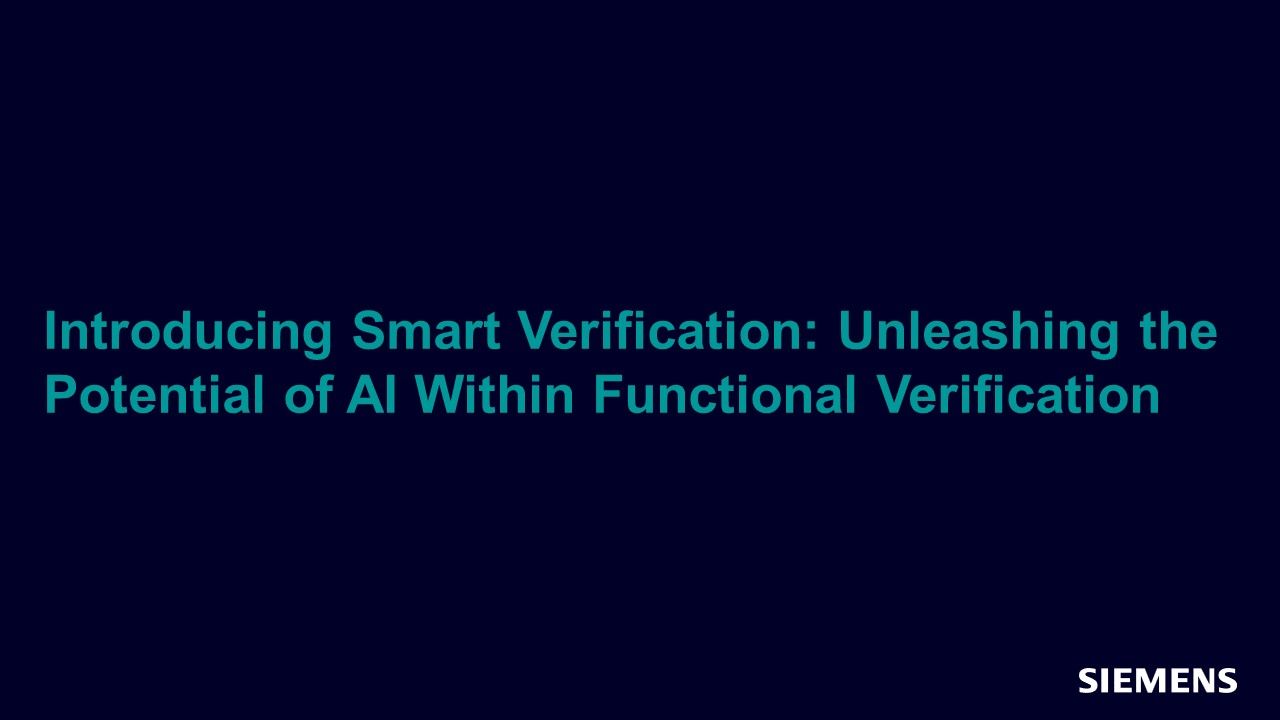Machine Learning
Machine learning (ML) has emerged as a powerful tool in the field of verification engineering, revolutionizing the way we validate and verify complex systems. Verification engineers are responsible for ensuring that hardware and software systems meet their specifications and perform reliably. In this context, machine learning offers a fresh approach to address challenges and enhance the verification process.
-

On-Demand
Introducing Smart Verification: Unleashing the Potential of AI Within Functional Verification
Leveraging the power of AI and ML, Smart Verification revolutionizes functional verification by using faster engines that complement traditional heuristics with machine learning. Allowing engineers to be more productive with advanced creation, analysis, and debugging capabilities, while reducing workloads through predictive technologies that streamline and accelerate the verification process.
-
Machine Learning Resources
-

-

The Future of Semiconductors: Engineering in the Convergence Era
Machine Learning Dec 09, 2025 Paper -
Industrial-Grade AI in EDA: From Promise to Practice — A Siemens Panel at DAC 2025
Machine Learning Jun 17, 2025 link -

-
Decoding LLM Hallucinations: Insights and Taming them for EDA Applications
Machine Learning Jun 15, 2023 link -
Big Data for Verification – Inspiration from Large Language Models
Machine Learning Feb 24, 2023 link -

-
-
Machine Learning Forum Discussion
-
Block Container: Introduction
-
Introduction
In the rapidly evolving landscape of verification engineering, the integration of machine learning (ML) has emerged as a transformative force that promises to reshape the way we validate and verify complex systems. Verification engineers are tasked with ensuring that hardware and software systems meet their specifications and operate reliably, a mission that often entails overcoming formidable challenges. In this context, understanding the fundamentals of machine learning is becoming increasingly important.
Machine learning, a subfield of artificial intelligence (AI), empowers systems to learn and improve from experience, much like how humans do. It has found its way into a wide range of applications, including natural language processing, image recognition, recommendation systems, and, most notably, in verification engineering. As verification engineers, you are accustomed to rigorous testing, manual analysis, and the quest for uncovering elusive system flaws. Machine learning introduces new tools and techniques that can augment your capabilities and streamline the verification process.
This introduction aims to provide verification engineers with a foundational understanding of machine learning, its principles, and its relevance to the field. By the end of this exploration, you will gain insights into how ML can be leveraged to automate tasks, enhance test generation, improve anomaly detection, optimize resource allocation, and contribute to the overall efficiency and reliability of verification processes.
In the subsequent sections, we will delve into the following key aspects:
- Fundamentals of Machine Learning: We will begin by demystifying the core concepts of machine learning, including supervised learning, unsupervised learning, and reinforcement learning. Understanding these fundamental paradigms will provide you with a solid foundation to comprehend the diverse applications of ML.
- Data-Driven Verification: One of the cornerstones of ML is its reliance on data. We will explore how verification engineers can harness historical data, simulation results, and past verification runs to train ML models. These models, in turn, can predict potential design flaws and system behaviors, enhancing your ability to identify and rectify issues efficiently.
- Automating Test Generation: ML introduces automation to the process of test case generation. By analyzing existing test cases and system behaviors, ML algorithms can autonomously generate new test cases, stress tests, and corner cases. This not only accelerates the testing process but also improves test coverage and increases the likelihood of identifying elusive defects.
- Anomaly Detection and Predictive Maintenance: ML models can be invaluable in anomaly detection, helping verification engineers identify deviations from expected system behavior in vast datasets. Additionally, in hardware verification, predictive maintenance becomes feasible through ML. By analyzing historical usage data, ML can forecast when hardware components or testing infrastructure may deteriorate, allowing for proactive maintenance and minimizing downtime.
- Performance Optimization: Machine learning extends its capabilities to the optimization of the verification process itself. We will explore how ML models can continuously monitor and analyze the verification pipeline, providing recommendations for resource allocation, parallelization strategies, and optimized test schedules, ultimately leading to more efficient verification cycles.
- Ethical Considerations: Lastly, we will address the ethical implications of incorporating machine learning into verification engineering. Ensuring that ML models are used responsibly and ethically is crucial, especially in safety-critical systems. We will discuss the importance of rigorous validation and testing to mitigate risks associated with false results or biases.
As verification engineers, you are at the forefront of ensuring the reliability and safety of complex systems. Machine learning presents an exciting opportunity to enhance your capabilities, streamline processes, and contribute to the development of more robust systems. Throughout this exploration, we will provide practical insights and examples to illustrate how machine learning can be harnessed to meet the evolving demands of the verification engineering landscape.
-
-
Block Container: Bullets
-
Column 1
Data-Driven Verification: One of the fundamental aspects of machine learning is its reliance on data. Verification engineers can leverage historical data and simulation results to train ML models. These models can then be used to predict potential design flaws or verify system behavior more efficiently. For example, ML models can identify patterns in previous verification runs, helping engineers prioritize test cases, identify bottlenecks, and allocate resources more effectively.
Automating Test Generation: Generating test cases is a crucial part of the verification process. Machine learning can automate this task by learning from existing test cases and system behavior. ML algorithms can generate new test cases, stress tests, and corner cases, significantly increasing test coverage and improving the chances of finding elusive bugs. This not only saves time but also enhances the quality of the verification process.
Anomaly Detection: Verification engineers often deal with large volumes of data generated during testing. Machine learning can be used to detect anomalies or deviations from expected behavior. Engineers can train ML models to recognize patterns in data and raise alerts when unexpected events occur, making it easier to pinpoint the source of a problem and address it promptly.
Performance Optimization: ML algorithms can help optimize the verification process itself. By continuously monitoring and analyzing the verification pipeline, machine learning models can suggest improvements, such as better resource allocation, parallelization strategies, or optimization of test schedules. This leads to faster verification cycles and more efficient resource utilization.
-
Column 2
Predictive Maintenance: In hardware verification, equipment reliability is critical. Machine learning can predict when hardware components or testing infrastructure might fail based on historical usage data. Engineers can proactively replace or maintain equipment to prevent costly downtime and delays in the verification process.
Natural Language Processing (NLP) for Requirement Analysis: Understanding and verifying complex system requirements can be a daunting task. NLP techniques can assist verification engineers in extracting and analyzing requirements from textual documents. ML-powered NLP tools can identify inconsistencies or ambiguities in requirements, helping engineers refine specifications and ensuring that verification efforts align with the intended system behavior.
Reducing Human Bias: Verification engineers may unintentionally introduce bias into their testing processes due to their expectations or prior knowledge of the system. Machine learning models are not influenced by such biases and can provide more objective insights into the verification results. This can help identify subtle issues that human engineers might overlook.
Challenges and Ethical Considerations: While machine learning offers numerous benefits to verification engineers, it also presents challenges and ethical considerations. ML models can sometimes produce false positives or false negatives, leading to wasted resources or missed issues. Additionally, ensuring the ethical use of ML, especially in safety-critical systems, is paramount. Engineers must carefully validate and test ML models to prevent unintended consequences.
-
-
Block Container: Conclusion
-
Machine Learning Advantages
Verification engineers can leverage machine learning (ML) to achieve numerous benefits in their field, enhancing the efficiency and effectiveness of the verification process. Here are five key advantages:
- Automated Test Case Generation: ML algorithms can analyze historical data and system behavior to autonomously generate test cases. This automation significantly increases test coverage, identifies corner cases, and helps detect elusive defects more efficiently. Verification engineers can save time and resources while improving the quality of their testing efforts.
- Anomaly Detection: ML models can be trained to identify anomalies or deviations from expected behavior in large volumes of verification data. This capability enables engineers to quickly detect and investigate issues, reducing the time and effort required to pinpoint the root causes of problems.
- Performance Optimization: Machine learning can optimize the verification process itself. By continuously monitoring and analyzing the verification pipeline, ML models can suggest improvements such as better resource allocation, parallelization strategies, and optimized test schedules. This leads to faster verification cycles and more efficient resource utilization.
- Predictive Maintenance: In hardware verification, predictive maintenance becomes possible with ML. By analyzing historical usage data, ML models can predict when hardware components or testing infrastructure may fail. This proactive approach allows verification engineers to schedule maintenance or replacements in advance, minimizing downtime and disruptions in the verification process.
- Enhanced Requirement Analysis: ML-powered natural language processing (NLP) techniques can assist verification engineers in extracting and analyzing requirements from textual documents. These models can identify inconsistencies or ambiguities in requirements, helping engineers refine specifications and ensure that verification efforts align with the intended system behavior.
These benefits not only streamline the verification process but also improve the overall quality of verification results, ultimately contributing to the development of more reliable and robust systems. Verification engineers can harness the power of machine learning to address complex challenges and stay competitive in an ever-evolving technological landscape.
-
Conclusion
In the rapidly evolving landscape of verification engineering, machine learning (ML) emerges as a disruptive force that is reshaping the very foundations of the field. This transformative journey into the realm of ML introduces innovative solutions to age-old challenges, presenting verification engineers with a wealth of possibilities for improved efficiency and effectiveness. As we delve deeper into the profound impact of ML on verification engineering, it becomes clear that this technological paradigm shift extends far beyond mere automation, touching upon various facets of verification processes, methodologies, and ethical considerations.
In conclusion, machine learning is revolutionizing the domain of verification engineering, offering novel solutions to enduring challenges. The shift towards data-driven verification, test automation, anomaly detection, predictive maintenance, and performance optimization showcases the breadth of ML's impact on the field. However, this transformation is not without its challenges and ethical considerations. Verification engineers must tread carefully, rigorously validating ML outputs and navigating the ethical complexities of this evolving landscape. By doing so, they position themselves to harness the transformative power of machine learning, ensuring the reliability and safety of complex systems in an ever-changing world.
-